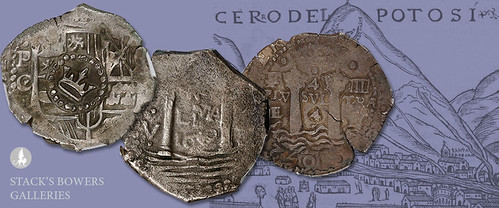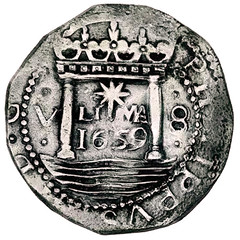
PREV ARTICLE
NEXT ARTICLE
FULL ISSUE
PREV FULL ISSUE
V25 2022 INDEX E-SYLUM ARCHIVE DEBASED SPANISH SILVER: THE "STAR OF LIMA"A Stack's Bowers blog article by Gabriel Solares discusses the 17th century debasement of Spanish silver coinage. -Editor
By the middle of the 16th century, Spanish dreams of finding the mythical city of
It did not take long for this trajectory to shatter. In the early 17th century, traders began to cast doubts on the fineness and weight of Potosi coinage. Once foreign governments stopped accepting silver Reales from Potosi at their nominal value, Spain was forced into action. In 1648, Philip IV sent the inquisitor Francisco de Nestares Marin to investigate. Within a year, Nestares Marin uncovered a vast web of corruption, with parties at all levels guilty of producing deliberately debased coinage and pocketing the difference. Over 100 implicated individuals received punishment, and several of the guiltiest were executed by strangulation, including the assayers Jeronimo Velasquez and Juan Rodriguez de la Rocha. Faulty coins were melted down and a new assayer took office, but these reforms were insufficient to restore global faith in Spanish silver. Furthermore, hoarding of the new specie created a disastrous shortage of circulating coinage. This crisis escalated to the point where the Viceroy of Peru, without the permission of the Crown, unilaterally reopened the Lima mint and produced the unique Things finally settled down in 1652 when, after a series of short-lived prototype issues, a new coin design was settled upon that included the date and assayer's name in at least three places. This bold new design ensured that the origins of faulty coins could be traced even in extremely crude examples. Sacrificing beauty for security, this type was in continuous production at Potosi until Cob coinage finally ceased more than a century later.
Our November 2022 Collectors Choice Online auction will feature Pat Johnson's vast collection of Latin American issues, including a nearly complete date run of Cobs from Potosi and Lima. Among them are rare issues of the later-executed assayers Velasquez and de la Rocha, seldom-seen transitional and countermarked types from 1652, and a coveted one-year
To read the complete article, see:
An article by Daniel Frank Sedwick on the sedwickcoins.com site describes the history of the
This is a case of
The design is where the moniker for this series of unauthorized coinage becomes obvious, for the central element on the obverse of each coin is a large star, which symbolized Lima from its founding as Ciudad de los Reyes (City of the Kings). In much smaller form the star was used on Lima's previous coinage under assayer Diego de la Torre, from 1577 to 1588 (with one more year of recorded production in 1592), placed interchangeably with the P mintmark, the oD assayer-mark and the denomination around the central obverse element (shield or monogram). The new version of Lima's star used in 1659 and 1660 was large and prominent.
To read the complete article, see:
Wayne Homren, Editor The Numismatic Bibliomania Society is a non-profit organization promoting numismatic literature. See our web site at coinbooks.org. To submit items for publication in The E-Sylum, write to the Editor at this address: whomren@gmail.com To subscribe go to: https://my.binhost.com/lists/listinfo/esylum All Rights Reserved. NBS Home Page Contact the NBS webmaster 
|


